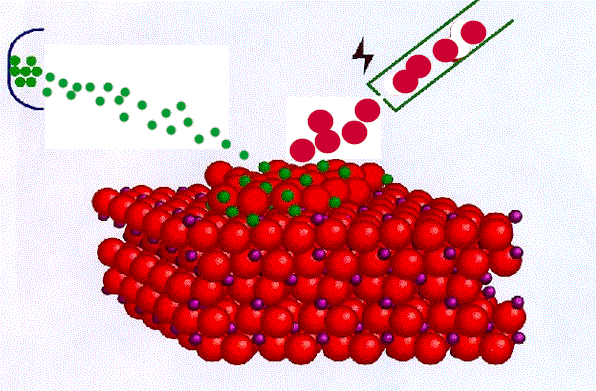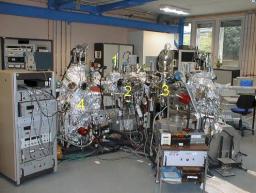Molecular beam epitaxy

The molecular beam epitaxy technique (MBE) was developed initially for the crystalline growth of the semiconductors. It is an ultra-high vacuum (P < 10-6 mbar) technology based on the sequential evaporation of the elementary components placed in Knudsen effusion cells. One of the advantages of this method rests on the control of the growth in real time thanks to the in situ use of the high energy electron diffraction in grazing incidence (RHEED).
Introduction chamber (1) equipped with a turbomolecular pump.
Preparation chamber(2)
- Gun allowing the ionic bombardment of surfaces (Ar+ ions of energy ranging between 1 and 8 keV).
- Oven allowing a heating until 1800°C by combining the Joule effect until 500°C and the electronic bombardment above. The temperature is measured by a thermocouple and/or an infra-red pyrometer.
- Gas introduction .
- Device of low energy electron diffraction (LEED Riber).
Analysis chamber (3)
- Source X Riber (not monochromatic): Al (hν = 1486.6 eV) or Mg (hν = 1253,6 eV).
- Detection by a hemispherical analyzer (Clam II of VG-scientific).
Growth chamber(4)
- Three Knudsen cells cooled by water allowing the evaporation of metals.
- Gun with ions of low energy (200 to 600 eV).
- Manipulator equipped to heat by Joule effect the substrate until 600°C during the deposition. The rotation of the sample holder is motorized.
- Thickness measurement by a balance with Inficon quartz cooled by water.
- Source of oxidation by monoatomic oxygen plasma.
- Gun RHEED (Staib Instrumente) which uses electrons with a primary energy ranging between 0 and 30 keV. The diffraction pattern is observed on a fluorescent screen. The geometry of the growth chamber allows an incidence of the electrons beam about a few degrees. The images are then recorded by a camera CCD cooled by Peltier effect. The recording and the analysis of the diffraction patterns (LEED and RHEED) are done using the KSA-400 software.
- quadripolar gas Analyser Inficon.
- CMA Auger Spectroscopy (PHI: Physical Instruments).
#494 - Màj : 22/07/2005
• Laboratory of Physics and Chemistry of Surfaces and Interfaces












